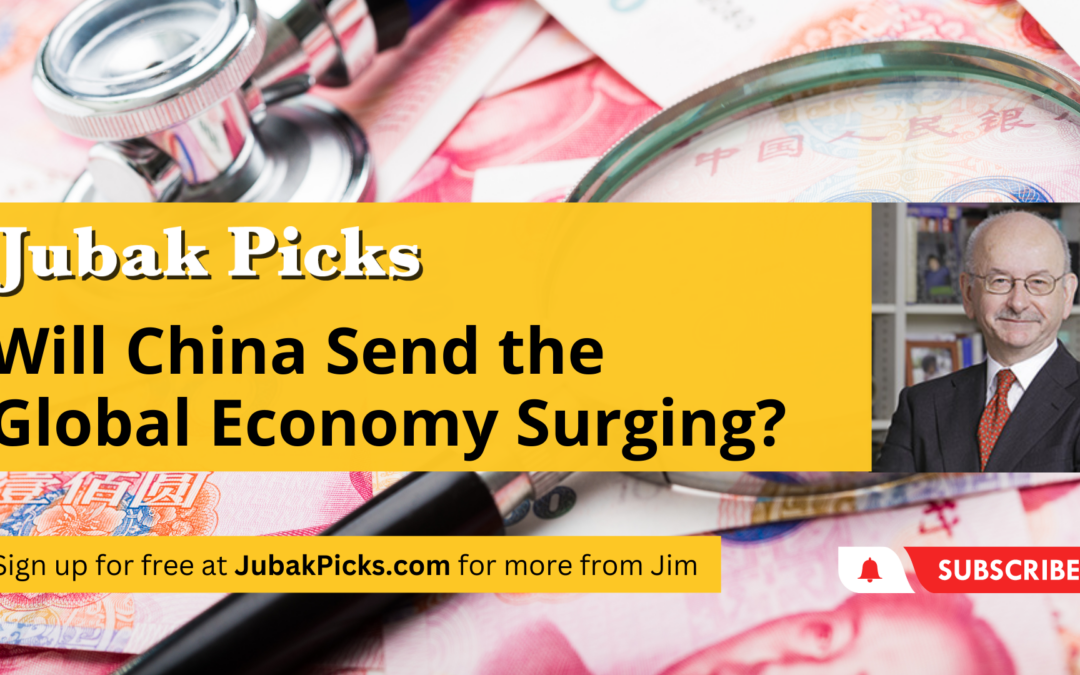
May 31, 2023 | Daily JAM, Perfect Five-ETFs |
The hits just keep on coming. On Wednesday, the release of May numbers on factory activity provided the most recent bit of bad news. China’s official manufacturing Purchasing Managers’ Index dropped to 48.8 this month, down from 49.2 in April, according to data released by the National Bureau of Statistics on Wednesday. It was the second straight contraction. In this index, a reading above 50 indicates expansion, while anything below that level shows contraction. The index, which mainly covers larger businesses and state-owned companies, is at its lowest level since December. In that month China ended most of its pandemic restrictions early that month. That led to hopes of a big economic rebound. And a strong stock market rally.
Now those hopes look premature or just plain exaggerated.

May 30, 2023 | Daily JAM, Perfect Five-ETFs, Videos, Volatility |
Today’s Quick Pick is Short iShares China Large-Cap ETF (FXI) COVID is back in China with a new peak of an estimated 65 million cases a week. It’s not as bad as the last peak which saw 35 million cases a day, but it’s enough that the economy will take a hit. And China’s reopening recovery was already looking a bit shaky. During the last wave of COVID, the iShares China Large-Cap ETF (FXI) fell to $20.95. The ETF rose steadily from that low on optimism over China opening back up. The economy didn’t bounce back as quickly as expected and FXI has stayed in the $27-$28 range recently. My suggestion is to buy an August Put Option. That will leave enough time for the COVID wave to play out. The August 18 Put with a strike price of 27, trades at just $1.00 or $100 for a contract of 100 shares of the ETF. That price makes this an affordable volatility play on a macroeconomic trend, and I’ll be adding this to my Volatility Portfolio portfolio on my paid site, JubakAM.com, and selling this ETF out of my Perfect 5 ETF Portfolio.

April 19, 2023 | BABA, Daily JAM, FXI, JD, Videos |
Today’s topic is China’s Economy is Back. On April 18, China reported 4.5% year-over-year GDP growth for the first quarter. While it wasn’t the 5% growth rate that the Chinese government has set as a target, it was better than the 4% forecast by economists. This growth rate comes on the heels of a 4th quarter with only 2.9% year-over-year growth. Other numbers showed strength too. For example, retail sales rose 10.6% year-over-year beating forecasts of 7.4%. But the economy isn’t cooking on all burners: Industrial production was up only 3.9%, just missing the forecasts of 4%. The iShares China Large-Cap ETF (FXI) is a good way to buy into China’s economy. There was a big rally from November to December as investors anticipated China’s economy speeding out of its Covid slump. But that rally was followed by a drop as the Chinese economy struggled with a resurgence in Covid cases. Now we’re seeing that drop start turn around. Individual stocks like Alibaba (BABA) and JD.com (JD) show charts with a similar pattern and can be expected to start to climb as the economy continues to pick up.

March 1, 2023 | Daily JAM, FXI, Perfect Five-ETFs, Videos |
Today’s topic is Will China Send the Global Economy Surging? We’ll really know the answer to this starting on Sunday, when the National People’s Congress of China meets. The leaders of China will make some important decisions for the Congress to rubber-stamp. China is looking for a 5% or higher GDP growth this year after last year’s 3%, but in order to get there, they’ll have to stimulate the economy. Local governments are drowning in debt that they can’t pay, and the government’s usual stimulus plan of requiring local governments to borrow and then spend it on “infrastructure “, isn’t likely to work. There’s also added pressure to cut interest rates to stimulate the economy and the rising tide (albeit a very low tide) of disgruntlement of the government and Xi Jinping’s leadership throughout the Covid lockdowns and the subsequent deadly spread of Covid-19. All this while the population is aging dramatically (with little to no retirement infrastructure), following the one-child policy, which reduced the younger population drastically. To take advantage of the expected and necessary economic stimulus, I recommend the iShares China Large-Cap ETF (NYSEARCA: FX) which captures a lot of the state-owned and larger corporate companies that would likely benefit from a stimulus from China. You’ll find it in my Perfect 5 ETF Portfolio.

March 1, 2023 | Daily JAM, EUM, FXI, Perfect Five-ETFs |
China’s manufacturing activity recorded its highest monthly improvement in more than a decade in February, while services also showed stronger-than-expected performance. Home sales rose for the first time in 20 months. Which has helped push Chinese stocks higher–along with the belief that the annual People’s Congress meeting that begins on Sunday will produce new stimulus measures from the central government.

February 6, 2023 | Daily JAM, Perfect Five-ETFs, Videos, Volatility |
Today I posted my two-hundred-and-thirty-third YouTube video: Trend of the Week China Accelerates This week’s Trend of the Week: China Accelerates. There is a horrific death toll in China as the country’s COVID policy changed dramatically, allowing COVID cases to surge wildly, spreading throughout the country and killing possibly a million people, but ultimately resulting (everyone hopes) in immunity. Now, Bloomberg is seeing a pick-up in China’s manufacturing activity and predicts 5.8% GDP growth in 2023, a huge bump from 3% in 2022. You can see this upswing by looking at the iShares China Large-Cap ETF (Nasdaq: FXI) as the market anticipates this GDP growth and a likely stimulus from the People’s Bank of China to make up for problems relating to the COVID crash. The iShares MSCI Emerging Markets ETF (EEM), which is an ETF that tracks at emerging markets as a whole and is heavily influenced by China, is also back on the upswing. I had been shorting EEM as China’s economy was dragging markets down, but I’ll be ending that short now. The bad thing about China being back is that it will start exporting inflation to the global economy, likely to the tune of about 100 basis points. Whether or not this will change the Fed’s timeline for pausing interest rates is unclear at this point. We can expect higher commodity prices, energy prices, and eventually, consumer prices as China continues its upswing. To follow more ETFs, go to my paysite, JubakAM.com.

December 12, 2022 | BABA, Daily JAM, FXI |
Just days after China’s government unwound its 0-Covid policy and eased lockdowns much earlier than expected, the country is seeing a surge of infection that already threatens to overwhelm hospitals. “The speed of changes on the ground has surprised many, including us,” Goldman Sachs Group Inc.’s chief China economist Hui Shan wrote in a note Sunday. “Not even a month ago, official outlets were still emphasizing that ‘20 measures’ were about optimizing the implementation of dynamic zero-Covid policy, rather than abandoning it. A few short weeks later, many controls are removed, and the virus seems to be spreading quickly among the population.” It’s unclear how quickly new cases are climbing

July 19, 2022 | Daily JAM, EUM, FXI, Perfect Five-ETFs |
I’m making a switch today (well, actually tomorrow) in the Perfect 5 ETF Portfolio Out goes the iShares Large Cap China ETF (FXI). In comes the ProShares Short MSCI Emerging Markets (EUM). My weighting remains the same at 15% of the five-ETF portfolio.

July 11, 2022 | Daily JAM, Morning Briefing |
China’s stocks took a beating today, July 11, on worries that the country is headed for a replay of the Pandemic lockdowns that battered the country’s economy earlier this year. In Shanghai, the flash point in the lockdown that ended just 5 weeks ago, the Covid case-load continued to march high. The city reported 59 new infections on Monday, the fourth day in a row with case numbers above 50. The sharp rise from single digits about a week ago follows the detection of the more contagious BA.5 sub-strain of the omicron variant. Nationally, close to 30 million people, are under some form of movement restriction. In Macao, state regulators moved to close all casinos for the first time since the early stages of the pandemic.

June 13, 2022 | BABA, Daily JAM, Videos |
My one-hundred-and-forty-fourth YouTube video “China Stocks Soar on End to Tech Crackdown” went up today. In the past few weeks–at least before the inflation/interest rate meltdown in U.S. markets,–I’ve seen an uptick in big China stocks like Alibaba (BABA), DiDi Global (DIDI), and JD.com (JD) on signs that Chinese regulators are easing up on tech stocks as the government tries to jump start China’s economy. If you’re looking for stocks that aren’t correlated to the U.S. economy and markets, I think this is a good time to revisit some of these stocks, especially JD.Com and the iShares China Large-Cap ETF (FXI)

May 17, 2022 | BABA, Daily JAM, FXI, Jubak Picks, Perfect Five-ETFs, TCEHY, Top 50 Stocks |
Today, Tuesday May 17, China’s top economic official, Vice Premier Liu He, said that the government will support the development of digital economy companies and their public stock listings. The comments delivered after a symposium with the CEOs of some of the country’s largest private technology companies came just a day after the National Bureau of Statistics reported that industrial output fell 2.9% in April from April 2021, and that retail sales contracted 11.1%. Financial markets in China and the United States interpreted the remarks as a public show of support for China’s Internet companies

April 29, 2022 | Daily JAM, Friday Trick or Trend, JJA, JO, Volatility |
There were very few places to hide in this week’s stock market decline. A number of the old reliable places to hide aren’t providing much protection in the current stock market drop. But I did see two splashes of green today among the sea of red.













